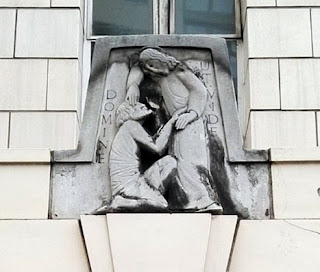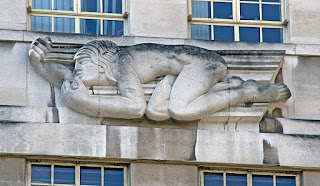Meaning for a while to write about Eric Gill and his work in
London, I was spurred on to finally get on and finish this post by reports in
the press a few weeks ago of a protester taking an axe to ‘offending’
sculptures at the BBC headquarters in Marylebone. Gill the man’s reputation was
actually shredded long before the current hoo-ha, but his work is always worth
a closer look.
 |
| Eric Gill 1882-1940 |
Gill started out training as an architect, coming to London for
that purpose in 1900, but was soon frustrated and so began evening classes
in stonemasonry and later calligraphy, enrolling on a course at
the Central School of Arts and Crafts run by Edward Johnston, creator of
the London Underground typeface and later a strong influence on Gill. During 1903,
Gill gave up architecture completely to become a calligrapher, letter-cutter
and monumental mason. WH Smith & Son employed
him to paint the lettering on the fascias of several of their bookshops,
including their Paris store.
Late in 1909 Gill decided to
become a sculptor. He collaborated often with Jacob Epstein, generally
acknowledged now to be much the more skilled at this art. Early in 1910 the
pair discussed with other artists, including Augustus John and Ambrose McEvoy,
the formation of a quasi-religious brotherhood uniting artists, craft workers
and priests.
By 1912, Gill's main source of income was tombstone inscriptions. He had also carved a number of Madonna figures and was widely, wrongly, assumed to be a Catholic artist. As such he was invited to an exhibition in Brussels of Catholic art and, on route, stayed for some days at the Benedictine monastery near Leuven. Gill's experiences at Leuven, seeing the monks at prayer and hearing plainsong for the first time convinced him to become a Roman Catholic and he and his wife were received into the Catholic Church. (He had married Ethel Hester Moore in 1904 and they would eventually have three daughters - Elizabeth, Petra, and Joanna - and foster a son, Gordian).
By the 1930s, Eric Gill was much lauded and the RSA made him a Royal Designer for Industry, the highest accolade for British designers - still awarded annually today. He went on to become a founder member of the RSA's Faculty of Royal Designers for Industry when it was established in 1938. In April 1937, Gill was elected an Associate Member of the Royal Academy.
 |
Station 9 Westminster Cathedral |
Gill sealed his reputation early with marblework and bas-reliefs in Westminster Cathedral depicting the 14 Stations of the Cross. Gill was just thirty-two when in April 1914 he produced his design (now in the British Museum) for the Stations. This design was approved the following month. The fourteen panels, each 5ft 8in square, were to be carved in low relief in Hopton Wood limestone for the very low price of £765. At this time Gill was almost unknown as a sculptor and extremely anxious to get such an important commission - hence the price. Once commissioned he set to work at once, producing the Tenth Station (Christ is stripped of his garments), for which he used himself as a model, and the Second (Christ receives the Cross) by November 1914. Then followed the Thirteenth (Christ is taken down from the Cross) and the First (Christ is condemned to death) by June 1915, the panels being carved in the studio with the final touches being added by Gill in the cathedral.
By June 1915 the first four
Stations were on view and almost immediately provoked widespread comment,
described on the one hand as 'grotesque and undevotional', ‘hideous,
primitive and pagan’. On the other hand they were seen as 'dignified in
conception, superb in outline and restrained in feeling' and as showing 'admirable
breadth and simplicity of design'.
 |
| Moorfields Hospital entrance |
Another of my favourite Gill works (from 1937) is the set of seven bas-reliefs decorating the Portland stone facade of the People’s Palace in Mile End (now the Great Hall of Queen Mary University of London). Two are above the doorways, each showing a languid figure representing Recreation, and five others representing Drama, Music, Fellowship, Dance and Sport.
 |
| People's Palace, Mile End |
But probably the best-known Gill sculptures are those found at these last two sites.
 |
| 55 Broadway |
55 Broadway, St James’s is the historic headquarters of London Underground, built between 1927 and 1929 by Charles Holden and encompassing St. James’s Park station. The building features a series of facade sculptures by leading artists of the day. Gill contributed three of the eight reliefs on the theme of winds.
 |
| The North Wind |
And so to the subject of recent controversy, Gill’s very prominent sculptures on BBC Broadcasting House in
 |
| 55 Broadway |
 |
| Prospero and Ariel |
 |
| The Sower |
Inside the BBC building at the main reception there is a further Gill work: The Sower, a man broadcasting seed. The statue, made of English marble (Hopton Wood Stone) stands more than 2.6 metres tall and occupies a niche by the doors leading to the artists' lobby and studios.
In addition to his sculptural work, Eric Gill was also a
consummate typographer. One of his first
independent lettering projects was creating an alphabet for WH Smith’s sign
painters. In 1927-30 he was commissioned by the typographer Morison to design
the Gill Sans typeface. In 1925, he designed the Perpetua , with the uppercase
based upon monumental Roman inscriptions, and in 1930-31 he created
Joanna which he used to hand-set his classic book ‘An Essay on Typography’.

Now one of the most widely used British typefaces, Gill Sans was used in the classic design system of Penguin Books and by the London and North Eastern Railway and later British Railways, with many additional styles created by Monotype both during and after Gill's lifetime. In the 1990s, the BBC adopted Gill Sans for its wordmark and many of its on-screen television graphics.
References:
The London Encyclopedia Ben Weinreb et al. (2008)
Hidden Treasures of
London Michael McNay (2015)
Website: https://www.westminstercathedral.org.uk/tour_stations.php
Website: https://art.tfl.gov.uk/projects/broadway-house/

